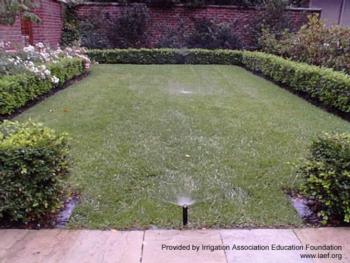Drought, Water Conservation, Landscape Water Use - Some Perspective
By Dennis Pittenger and Donald Hodel (For the full article see here)
Starting in 2015, landscape plants and the water they use began to experience unrelenting attack as California continues struggling with drought conditions and limited water supplies. The intense focus on mandated landscape water cutbacks in 2015 stirred me and UC Cooperative Extension colleague, Donald Hodel, to look at recent research and other data related to landscape water use in California. Here is an summary of the facts we found and our 2015 analysis to give perspective on the situation.

Landscape water use in California accounts for only 9% of the total statewide developed water use (fig. 1). Yes, if California’s home and public landscapes, parks, sports fields, and golf courses were not irrigated the State would save about 9% of its water consumption. Of this statewide 9%, residential use accounts for about 7% while parks, golf courses, sports fields, and other large landscapes account for 2%. Lawns, which have been especially singled out as water wasting culprits, are estimated to use about 40% to 60% of landscape irrigation in California, or just 3.5% to 5% of total statewide water use. Overall, landscape irrigation is estimated to account for about 50% of annual residential water consumption statewide. That amount varies widely from about 30% in many coastal communities to 60% or more in various inland suburban communities.
The amount of water used by landscapes seems small considering the essential functions and innumerable benefits landscapes provide to enhance the quality and livability of California’s urban areas, including recreation; psychological well-being; cooling shade that saves energy; rain capture, dust and erosion control; carbon dioxide reduction and oxygen generation; enhanced property values; wildlife habitat; and, of course, beauty. While many Californians consider public and private landscapes to be essential and, therefore, their irrigation to be a beneficial use of water, current state and local policies tend to view landscapes as unnecessary or wasteful use of water.
Landscape water use research and other horticultural science shows we can have our landscape plants, including limited areas of functional lawns, meet water reduction goals, and still have the numerous functions and quality of life benefits that landscape plants provide. Significant water can be saved simply by reducing the amount of irrigation typically applied to existing landscapes. Research has clearly shown that many if not most common trees, shrubs, and groundcovers traditionally used in California landscapes are actually very drought tolerant and low water using once established and irrigated properly, but they are usually over watered. Studies found that woody plants and other non-turf plants, in general, perform well with up to 55% less water than that needed by the average tall fescue lawn. So, it is unnecessary to replace completely existing lawns or other landscape plantings with so-called drought-tolerant or low-water use plants, like desert or Mediterranean-climate plants or California natives, in order to reduce a landscape’s water demand significantly and meet mandated cutbacks.
Similarly, considerable water can be saved in existing lawns to get through a drought period. Lawn irrigation can be reduced up to 20% to 30% for several weeks without killing the turf, although it will have extensive brown areas, little growth, and thin coverage because water shortage forces it into dormancy. Lawns growing tall fescue, the most common California lawn grass, can realize a permanent 20% reduction in water demand by replanting with bermudagrass, zoysiagrass, St. Augustinegrass, or buffalograss, if winter over seeding is avoided.
Many water conservation strategies call for an end to lawn irrigation or removing lawn altogether. Removing a lawn will only bring water savings if it is replaced with no plants and the irrigation is turned off, or if a tall fescue or similar cool-season grass lawn is replaced with trees, shrubs, or groundcovers and these are irrigated to their requirements, which can be an expensive procedure if done properly. If water is turned off to lawns, trees and shrubs solely dependent on lawn irrigation to meet their water needs may suffer, decline, and even possibly die. Declining and dead trees are particularly hazardous because they can readily drop large limbs or the trunk can eventually fail, causing serious risk to life and property. If water is only applied to sustain the trees in a turf area, some of the grass will likely survive although the turf will be of poor quality.
Looking at the facts, it seems unlikely that California will be able to conserve its way out of a serious drought by focusing primarily on water conservation that targets lawn removal and severe reductions in water applied to landscapes. Trying to wring out significant savings from the 9% of water that landscapes consume will severely damage or greatly reduce plantings and result in the loss of landscapes’ essential functions and benefits. Landscape plants are beneficial, justify the use of water, and are a worthwhile investment, even in this historic drought. The statewide policy for the past decade has been to meet the water demands from growth largely through landscape water conservation. This policy is a failed long-term strategy, however, because reallocating the water saved in landscape irrigation to meet fundamental water needs of increased population results in hardening of water demand since there is less easy-to-conserve water in times of drought. Crucial public policy and decisions on water use, allocation, and distribution need to consider Californians’ quality of life requisites and be based on science, not illusion or perception.
